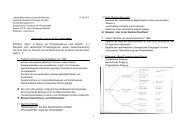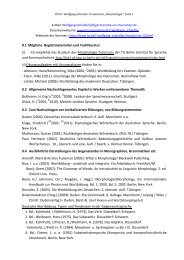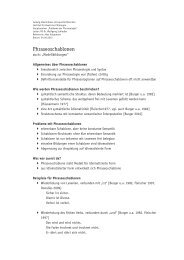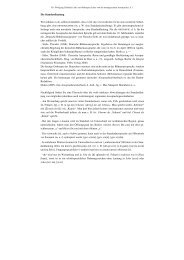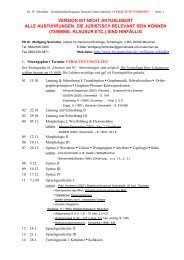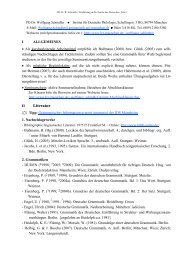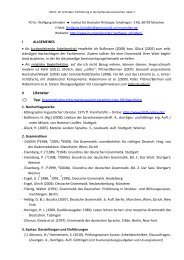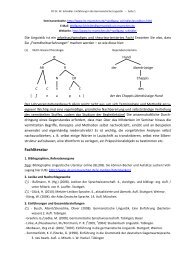Chapter 18 Lexical Functions: Description of Lexical Relations in a ...
Chapter 18 Lexical Functions: Description of Lexical Relations in a ...
Chapter 18 Lexical Functions: Description of Lexical Relations in a ...
Create successful ePaper yourself
Turn your PDF publications into a flip-book with our unique Google optimized e-Paper software.
—<strong>Chapter</strong> <strong>18</strong>. <strong>Lexical</strong> <strong>Functions</strong>— 39<br />
L´, an element <strong>of</strong> Able i(L), names the determ<strong>in</strong><strong>in</strong>g property <strong>of</strong> the (referent <strong>of</strong> the) i-th<br />
potential DSynt-actant <strong>of</strong> L. More precisely, Able 1 means (which can/tends to L), and Able 2,<br />
(which can/tends to be L-ed); thus, the mean<strong>in</strong>g <strong>of</strong> Able i(L) <strong>in</strong>cludes that <strong>of</strong> L.<br />
Examples<br />
Able 1(cryV) = tearful Able 1(varyV) = variable<br />
Able 2(proveV) = provable Able 2(trustV) = trustworthy<br />
Rus. Able 2(somnevat´sja (doubtV)) = somnitel´nyj lit. (doubtable)<br />
Rus. AntiAble 2(somnevat´sja (doubtV)) = nesomnennyj lit. (undoubtful) =<br />
(such that one cannot doubt it)<br />
Cf. also:<br />
S 1Able 1(cryV) = crybaby<br />
S 1Able 1Caus(cryV) = tearjerker [a movie, a book]<br />
S 1Able 2(laugh2V) = laugh<strong>in</strong>g stock<br />
<strong>18</strong>. Qual i [Lat. qualitas (quality)] = qualify<strong>in</strong>g actantial adjectives<br />
L´, an element <strong>of</strong> Qual i(L), names the determ<strong>in</strong><strong>in</strong>g property <strong>of</strong> the i-th probable DSynt-<br />
actant <strong>of</strong> L, that is, the property such that it entails the tendency <strong>of</strong> the referent <strong>of</strong> this actant to<br />
L/to be L-ed; the mean<strong>in</strong>g <strong>of</strong> Qual i(L) does not <strong>in</strong>clude that <strong>of</strong> L.<br />
Examples<br />
Qual 1(cryV) = sad<br />
Qual 1(laugh1V) = cheerful<br />
Qual 1(w<strong>in</strong> [over NY]) = strong<br />
Qual 1(prove) = logical<br />
Qual 2(doubtV) = implausible<br />
Qual 2(laugh2V) = awkward; absurd<br />
Qual 2(w<strong>in</strong> [over NY]) = weak<br />
Qual 2(prove) = obvious<br />
Qual i entails the probability <strong>of</strong> Able i but not vice versa: if someth<strong>in</strong>g is implausible it<br />
tends to be doubtful, but a doubtful statement is not necessarily implausible; an obvious state-<br />
ment is likely to be provable, but someth<strong>in</strong>g provable is by no means always obvious; etc.<br />
LFs 19 and 20 are, roughly speak<strong>in</strong>g, ‘quantifiers:’ a s<strong>in</strong>gulative and a collective. They are<br />
<strong>in</strong>verse with respect to each other:<br />
(S<strong>in</strong>g(Mult(L1))) ≈ (L1) and (Mult(S<strong>in</strong>g(L2))) ≈ (L2).


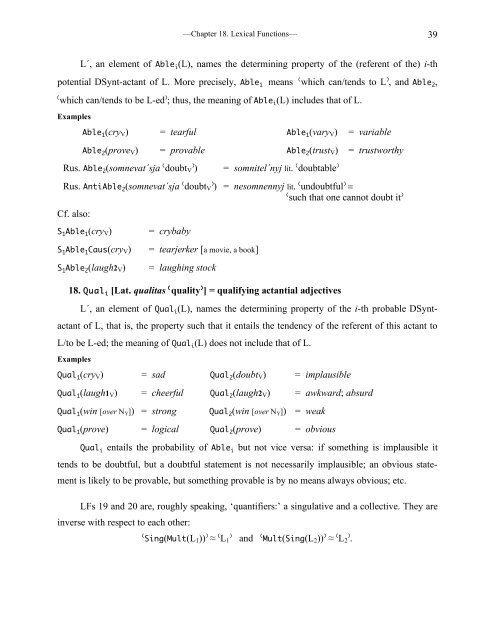
![E-Mail: Wolfgang.Schindler[ätt]germanistik.uni-muenchen.de Web ...](https://img.yumpu.com/51590147/1/184x260/e-mail-wolfgangschindlerattgermanistikuni-muenchende-web-.jpg?quality=85)
